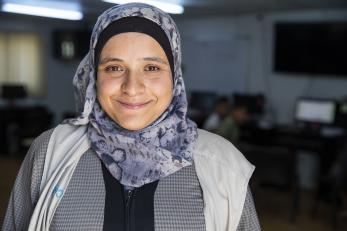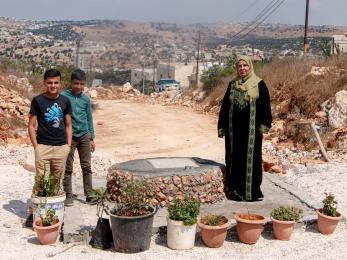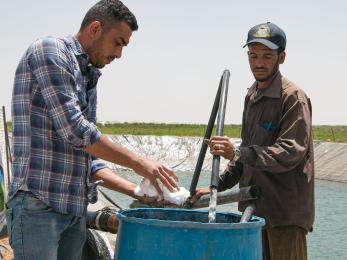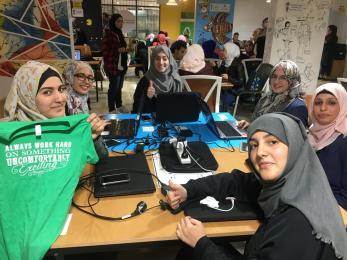Measuring the Impact of Refugee Labor Inclusion on the Host State Economy

Mercy Corps partnered with West Asia-North Africa (WANA) Institute, a non-profit policy think tank based in Amman, Jordan, on a series of research products to quantify and track labor integration impacts in Jordan from a multi-sectoral perspective.
The body of research measures and tracks actual economic and social cohesion outcomes using quantitative and qualitative data collected over a 3 year period. The findings provide an objective starting point for a transition in thinking about refugee contributions to host state economies, the most efficient uses of donor aid and improved structuring of worker rights’ policies in Jordan and on a global scale.
Further, the research provides Mercy Corps Jordan with an increased understanding of the status of Syrian labor, its effects on the opportunities of other foreign labor, and the government’s efforts towards providing Syrian refugees access to work permits, as well as the effect on national investments and economic activities.
Download the infographic brief here ▸
-
Summary: The Syrian Refugee Crisis in Jordan and Its Impact on the Jordanian Economy
In late 2016 — just months after the signing of the Jordan Compact — the WANA Institute and Mercy Corps set out to measure the impact of Syrian labor on Jordan’s economy. This research initiative, which has spanned two years, has resulted in several publications. Notable highlights and key conclusions from the last reports — ‘Syrian Refugee Return: Implications for the Jordanian Host State,’ ‘The Syrian Refugee Crisis and Its Impact on the Jordanian Labour Market,’ and ‘Investment and Employment Trends in Jordan’s Key Economic Sectors,’ — are introduced in this executive summary.
-
Chapter 1: Syrian Refugee Return: Implications for the Jordanian Host State
This report — the first in a series of three studies — includes initial viewpoints on how the return of Syrian refugees would impact Jordanian labor, employment, housing rents, consumption, and government spending. Drawing primarily on the first-hand accounts of community-based organizations in Amman, Irbid, Mafraq, and Zarqa, the report highlights some of the systems that have developed due to the humanitarian response as well as some of the contributions that Syrian labor has made to business services across the Kingdom.
-
Chapter 2: The Syrian Refugee Crisis and Its Impact on the Jordanian Labour Market
This report — the second piece in a three-part study — reviews the body of research that has been conducted on Syrian participation in the labor market and assesses the impact that Syrian refugees had on the Jordanian labor market between 2012 and 2016.
-
Chapter 3: Investment and Employment Trends in Jordan’s Key Economic Sectors
This report is a step-by-step review of sector-level real GDP, employment, and capitalization in Jordan — figures that together determine the sensitivity of employment to investment. The analysis provides a quantitative framework for approaching the policy debate on investment and employment across key economic sectors of the Jordanian economy. The figures presented on agriculture, construction, manufacturing, and selected services draw on the best available data from recent years to tell the story of each of these sectors, while drawing attention to the implications of, and trade-offs between, employment growth, capitalization and productivity.
-
Managers’ Reflections on Sub-Sector Performance, Investment, Worker Profile, and Technology Trends
In an effort to understand the outlook, trends and overriding characteristics of Jordan’s manufacturing sector, the WANA Institute conducted a series of interviews with firm managers across ten industrial sub-sectors. Discussions taking place over the course of 30 interviews explored questions on the performance of the sub-sector, recent and future investments in fixed assets, human capital investment and training, notable skills gaps and future technology trends. The interviews provide reflections, rather than concrete figures, on trends shaping the business environment in ten different industrial sub-sectors.
-
Syrian Refugee Labour Inclusion Policy In Jordan: Emerging Trends Two Years In
April 2018 marked two years of Jordan’s landmark decision to allow limited working rights to Syrian refugees. This report provides an overview of the progress that has been made, the challenges that remain and the strategies that have been put in place to speed up the pace of Syrian refugee worker inclusion in Jordan.
-
Syrian Refugee Women and the Workforce in 2017
The employment of refugee women is a recurrent concern for international organizations and NGOs whose programs provide protection and basic needs. Refugee women are commonly viewed as more vulnerable and at greater risk of poverty than their male counterparts. In the current context, many have sought refuge in Jordan without their husbands, and many serve as the head of household. Their participation in the labor market is a growing point of interest for stakeholders seeking to make livelihoods more accessible to Syrian refugees.
-
Syrian Refugees and Social Cohesion in Jordan
While there have been multiple efforts to assess Syrian refugees’ intentions to enter the formal labor market, little has been done to gauge how Jordanian workers perceive the policy. In order to gain a cursory understanding of this, in September 2017, the WANA Institute conducted Focus Group Discussions (FGDs) across factories in Amman, Irbid and Mafraq. Participants were Jordanian factory workers — a population that could, in both the present and future — be in direct competition with Syrian workers for factory jobs.
-
Nine Recommendations to Bolster the Jordan Compact
Since its signing in February 2016, the Jordan Compact has been hailed as an innovative, holistic approach that prioritizes development goals in the context of a protracted humanitarian crisis. Yet as the much-hoped-for growth in exports to Europe — a cornerstone of the agreement — has failed to materialize (as of July 2017 only two Jordanian companies had benefited from the relaxed rules of origin arrangement) stakeholders may be growing weary. Here are nine recommendations to recalibrate objectives and boost momentum.
-
Jordan’s Recent Economic Performance: Implications for Future Growth, Investment, Refugee Policy and Refugees
In February 2016, the landmark Jordan Compact was signed between Jordan and a range of donor countries and international organizations. This series of pivotal events must be understood against two largely unrelated narratives that are at the core of the country’s modern economic history. The first is Jordan’s long-standing goal of positioning itself as a high-value-added, knowledge-based economy within the West Asia-North Africa region. The second is the apparent divergence between investment and employment growth that has been recently noted in five industrial sectors. The positioning of the two narratives in relation to the Syrian refugee crisis presents a new set of questions for Jordan, as well as the international financial institutions whose job it is to advise Jordan on its medium-to-long-term economic growth strategy. This report provides a first step toward untangling these questions and sets an agenda for additional research that we hope will inform the future designation of priority sectors and investments.
-
Syrian Refugee Labour Integration Policy in Jordan
Jordan's policy to provide limited worker rights to Syrian refugees went into effect in April 2016. A wide range of stakeholders have supported the effort to formalize Syrian labor. Official data suggests that the Syrian refugee crisis has had little impact on leading macroeconomic indicators. Yet it is unlikely that the influx of such a large number of people has not affected labor market conditions. The paper reviews the performance of macroeconomic and Syrian refugee financial outcome indicators during the first year of the labor integration policy and the Jordan Compact.
-
Syrian Refugees and Social Cohesion in Jordan: A Closer Look at Farming Communities in the Jordan Valley
Farming plays an instrumental role in Jordan's society, a field that has brought together Jordanian and Syrian workers. This report highlights Jordanian farmers' views of their Syrian colleagues, the nature of social ties, and integration between them. The findings of this report are based on three focus groups conducted in the al-Ghor region of Jordan’s Balqa governorate in late December 2018 by the WANA Institute, in partnership with al-Karamah Charity Association.


